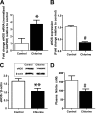Chlorine gas exposure causes systemic endothelial dysfunction by inhibiting endothelial nitric oxide synthase-dependent signaling
- PMID: 21131444
- PMCID: PMC3175567
- DOI: 10.1165/rcmb.2010-0151OC
Chlorine gas exposure causes systemic endothelial dysfunction by inhibiting endothelial nitric oxide synthase-dependent signaling
Abstract
Chlorine gas (Cl(2)) exposure during accidents or in the military setting results primarily in injury to the lungs. However, the potential for Cl(2) exposure to promote injury to the systemic vasculature leading to compromised vascular function has not been studied. We hypothesized that Cl(2) promotes extrapulmonary endothelial dysfunction characterized by a loss of endothelial nitric oxide synthase (eNOS)-derived signaling. Male Sprague Dawley rats were exposed to Cl(2) for 30 minutes, and eNOS-dependent vasodilation of aorta as a function of Cl(2) dose (0-400 ppm) and time after exposure (0-48 h) were determined. Exposure to Cl(2) (250-400 ppm) significantly inhibited eNOS-dependent vasodilation (stimulated by acetycholine) at 24 to 48 hours after exposure without affecting constriction responses to phenylephrine or vasodilation responses to an NO donor, suggesting decreased NO formation. Consistent with this hypothesis, eNOS protein expression was significantly decreased (∼ 60%) in aorta isolated from Cl(2)-exposed versus air-exposed rats. Moreover, inducible nitric oxide synthase (iNOS) mRNA was up-regulated in circulating leukocytes and aorta isolated 24 hours after Cl(2) exposure, suggesting stimulation of inflammation in the systemic vasculature. Despite decreased eNOS expression and activity, no changes in mean arterial blood pressure were observed. However, injection of 1400W, a selective inhibitor of iNOS, increased mean arterial blood pressure only in Cl(2)-exposed animals, suggesting that iNOS-derived NO compensates for decreased eNOS-derived NO. These results highlight the potential for Cl(2) exposure to promote postexposure systemic endothelial dysfunction via disruption of vascular NO homeostasis mechanisms.
Figures






Similar articles
-
Chlorine gas exposure disrupts nitric oxide homeostasis in the pulmonary vasculature.Toxicology. 2014 Jul 3;321:96-102. doi: 10.1016/j.tox.2014.04.005. Epub 2014 Apr 24. Toxicology. 2014. PMID: 24769334 Free PMC article.
-
Atorvastatin restores the impaired vascular endothelium-dependent relaxations mediated by nitric oxide and endothelium-derived hyperpolarizing factors but not hypotension in sepsis.J Cardiovasc Pharmacol. 2009 Dec;54(6):526-34. doi: 10.1097/FJC.0b013e3181bfafd6. J Cardiovasc Pharmacol. 2009. PMID: 19755915
-
Hypoglycaemia aggravates impaired endothelial-dependent vasodilation in diabetes by suppressing endothelial nitric oxide synthase activity and stimulating inducible nitric oxide synthase expression.Microvasc Res. 2023 Mar;146:104468. doi: 10.1016/j.mvr.2022.104468. Epub 2022 Dec 10. Microvasc Res. 2023. PMID: 36513147
-
Pharmacological targeting of endothelial nitric oxide synthase dysfunction and nitric oxide replacement therapy.Free Radic Biol Med. 2025 Sep;237:455-472. doi: 10.1016/j.freeradbiomed.2025.06.009. Epub 2025 Jun 10. Free Radic Biol Med. 2025. PMID: 40505746 Review.
-
The NO cascade, eNOS location, and microvascular permeability.Cardiovasc Res. 2010 Jul 15;87(2):254-61. doi: 10.1093/cvr/cvq139. Epub 2010 May 11. Cardiovasc Res. 2010. PMID: 20462865 Free PMC article. Review.
Cited by
-
Transient receptor potential channels in pulmonary chemical injuries and as countermeasure targets.Ann N Y Acad Sci. 2020 Nov;1480(1):73-103. doi: 10.1111/nyas.14472. Epub 2020 Sep 6. Ann N Y Acad Sci. 2020. PMID: 32892378 Free PMC article.
-
Chlorine gas exposure disrupts nitric oxide homeostasis in the pulmonary vasculature.Toxicology. 2014 Jul 3;321:96-102. doi: 10.1016/j.tox.2014.04.005. Epub 2014 Apr 24. Toxicology. 2014. PMID: 24769334 Free PMC article.
-
Inhaled matters of the heart.Cardiovasc Regen Med. 2015;2:e997. doi: 10.14800/crm.997. Epub 2015 Sep 20. Cardiovasc Regen Med. 2015. PMID: 26665179 Free PMC article.
-
Halogen Inhalation-Induced Lung Injury and Acute Respiratory Distress Syndrome.Chin Med J (Engl). 2018 May 20;131(10):1214-1219. doi: 10.4103/0366-6999.231515. Chin Med J (Engl). 2018. PMID: 29722341 Free PMC article. Review.
-
Post-exposure antioxidant treatment in rats decreases airway hyperplasia and hyperreactivity due to chlorine inhalation.Am J Respir Cell Mol Biol. 2012 May;46(5):599-606. doi: 10.1165/rcmb.2011-0196OC. Epub 2011 Dec 8. Am J Respir Cell Mol Biol. 2012. PMID: 22162906 Free PMC article.
References
-
- Evans RB. Chlorine: state of the art. Lung 2005;183:151–167. - PubMed
-
- Almagro Nievas D, Acuna Castillo R, Hernandez Jerez A, Robles Montes A. Investigation of an outbreak of acute respiratory illness due to exposure to chlorine gas in a public swimming pool [in Spanish]. Gac Sanit 2008;22:287–290. - PubMed
-
- Cevik Y, Onay M, Akmaz I, Sezigen S. Mass casualties from acute inhalation of chlorine gas. South Med J 2009;102:1209–1213. - PubMed
Publication types
MeSH terms
Substances
Grants and funding
LinkOut - more resources
Full Text Sources
Molecular Biology Databases

